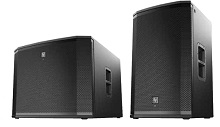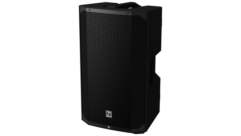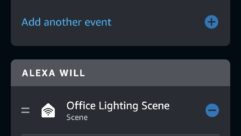

Electro-Voice ETX Series Review
Nov 11, 2014 7:00 PM, Reviewer: John McJunkin
There are three broad markets for portable powered speakers—consumer, prosumer, and professional. As a professional who hopes to operate profitably, I’m most interested in the prosumer domain. It presents the strongest likelihood for products that exhibit professional quality with pricing that leans more toward the consumer end. In assessing this balance, I consider reproduction quality and quantity, along with weight, portability, application options, and overall ease of use.
I was sent a pair each of Electro-Voice’s ETX-15P portable powered loudspeakers and ETX-18SP powered subwoofers, and I spent time evaluating them based on these attributes. I discovered that although ETX series pricing is pretty squarely in the prosumer domain, the performance is a bit north of there. I reviewed EV’s ZLX series speakers previously, and found them to deliver good, but not necessarily great or excellent fidelity—and considering pricing, that was not unexpected. I was excited to get my hands on the ETX series so as to draw a comparison. My expectations for the ETX boxes were elevated, and as it turns out, they are substantially better, indeed.
Electro-Voice’s ETX-18SP powered subwoofer and ETX-15P portable powered loudspeaker
I will concede that while I prefer the sound quality of wood speaker cabinets over plastic, I do not prefer carrying wood cabinets compared with plastic cabinets. When I first saw the ETX speakers and the large palette-stacked boxes in which they were delivered, I groaned a bit, knowing I’d have to unpack and move them around myself. I was pleasantly surprised to discover, however, that the ETX-15P speakers were not as heavy as they looked—61lbs. each. Lifting them for pole mounting is still a two-person job, but my 13-year-old helper and I had no trouble with them at all. I also was happy to find that the ETX-18SP subwoofers, with their considerable 114lbs. mass, had the optional casters offered by Electro-Voice. By leveraging carpeting or moving blankets, it’s plausible to slide the subs in and out of a vehicle, and the casters then make 114lbs. subs seem more like 75lbs. subs. The cabinets feature die-cast aluminum metal handles and hardware, the grilles are 16AWG powder-coated steel, and the boxes are covered in the manufacturer’s synthetic EVCoat, which is good, tough stuff. The ETX-15Ps feature eight M10 suspension points and skids on which to lay the speaker for 40-degree floor wedge placement. Of course, they are intended primarily for pole mounting, and have a die-cast aluminum structure with two M20 pole receptacles offering perfectly vertical zero-degree placement or a downward tilt of 7.5 degrees. The ETX-18SPs are stackable, up to three units high, and feature recessed receptacles atop their cabinets for the rubber feet attached to the bottom of the speaker above.
The ETX-15P’s LF driver is EV’s 15in. SMX2150, and the HF driver is EV’s DH3-B, which is a 1.25in. titanium compression driver. The crossover point between them is set at 1500Hz (with a finite impulse response (FIR)-based crossover that exhibits a very steep slope —76dB/octave), and the dispersion pattern of the HF driver’s waveguide is 90°x60°. The cabinet is a bass-reflex design with the port located directly below the HF waveguide, with the intent of minimizing distortion and standing waves inside the enclosure. The FIR technology used in the system requires a lot more CPU horsepower than traditional infinite impulse response (IIR) technology. But advances in computing power have made it plausible, and EV deployed it in this series just as they did in their FIR Drive touring systems. The ETX- 18SP employs a bass-reflex topology, as well, and very successfully so with its EV DVX3180A 18in. driver. Both kinds of speakers feature Class D amplification, which contributes significantly to keeping the enclosures from becoming ridiculously heavy.
The ETX-15P offers two input channels, which could, for instance, be handy for a coffee-shop singer/songwriter, who could plug a guitar into one channel and a mic into the other, and control level for each independently. A physical potentiometer determines input level for each of these channels, and the only other control found on the speaker’s I/O panel is the digital rotary encoder found to the right of the speaker’s LCD display panel. That knob is also a pushbutton used to navigate and confirm the user’s choices. An XLR output jack provides a mix of both inputs as determined by the user—useful for daisy-chaining. The ETX-18SP’s I/O panel is similar, but simpler, with the same LCD display and digital rotary encoder pushbutton, but with two XLR inputs and two XLR outputs, corresponding to the speaker’s two discreet channels. The outputs simply mirror the inputs, with high-pass filtering applied per the user’s settings.
The ETX-15P’s DSP was easy for me to operate with the single knob/pushbutton. It facilitates selection of one of the system’s three broad presets: music (graphic EQ smiley curve), live (flat), and speech (emphasis of key speech frequencies). Boundary compensation is available in the DSP, as well, with presets for tripod, monitor, array, wall, or suspended placement. High-pass cutoff frequency for sub integration is also established in this menu, as are the curves of the speaker’s three-band semi-parametric EQ. The DSP also offers delay of up to 1125ft., adjustable in ¼-meter or 1ft. increments, depending on whether delay is displayed in meters or feet. The remaining options submenu grants control over the speaker’s front light, display, measurement increments, system locking, and system reset. The ETX-18SP’s DSP menu is similar, offering selection of one of its two broad presets: music and live. It determines whether the speaker is used in a normal mode, or cardioid mode, in which subs are stacked with drivers facing both forward and back, and internal DSP applied to the rear-facing cabinets to achieve a cardioid dispersion pattern with up to 30dB of rejection to the rear, which can be very useful. As with the full-range speaker, the subwoofer’s DSP menu controls high-pass cutoff frequency, three-band semi-parametric EQ, and delay. It adds to this the capacity to reverse input signal polarity. The remaining submenus grant control over the front light, display, measurement increments, system locking, and system reset, as with the full-range speaker.
As I stated earlier, my expectations were influenced by my prior review of EV’s consumer-level portable powered speakers and foreknowledge of the fact that the ETX series was developed to be significantly superior. I listened to a lot of music from a wide array of genres to assess the speakers for DJ usage, mixed multiple inputs to assess them for live sound, and appraised the reproduction of both male and female voices delivering spoken word. I also evaluated audio from corporate presentations, and both film and broadcast television sound. With the input levels of the subwoofers and full-range speakers matched at 0dB, the system sounds very well balanced, with no unpleasant hole at the crossover point. The manufacturer’s published frequency response curves appear to be honest, based on my listening. The bass is abundant, and it’s apparent that the drivers were well designed and properly constructed, both 15in. and 18in. units. The HF driver, however, is the more impressive of the components in my estimation. It is clear, clean, and sounds very smooth to my ear with a minor boost in the highs to perfect the response for my nearly 50-year-old ears, which have dulled over time.
Everything I threw at these speakers sounded marvelous, and I could detect virtually no distortion even at SPLs that were ridiculously high. A bit of self-noise is apparent if you step right up to the cabinet, but it’s not distracting. Considering our original handful of standards we set to determine the overall value, I’ll say that the reproduction quality and quantity are both excellent, the weight is not a deal-breaker, particularly with the subwoofer casters deployed, which also adds to portability. The size, portability, and fidelity over a wide range of input signals makes them very versatile, and despite the sophisticated nature of the DSP, the speakers are easy to use. Bottom line—the Electro-Voice ETX series is an excellent value, providing high-quality reproduction for a wide range of applications, and they won’t break the bank.
John McJunkin is the principal of Avalon Podcasting in Chandler, Ariz., and produces and co-hosts a top-rated morning radio talk show in Phoenix. He has consulted in the development of studios and installations, and provides high-quality podcast and voice production services.
Product Summary
Company: Electro-Voice | www.electrovoice.com
Product: ETX Series Powered Speakers
Pros: Surprisingly light despite solid build quality, huge SPL, great quality
Cons: N/A
Applications: Corporate audio, rental companies, pro musicians, DJs, installed sound
Price: $1,499 (ETX-18SP); $1,299 (ETX-15P)
Specifications
ETX-15P 15in. Portable Powered Loudspeaker
• Frequency Response (-3dB): 48Hz–20kHz
• Frequency Range (-10dB): 40Hz–20kHz
• Maximum SPL: 135dB peak
• Coverage (HxV): 90°x60°
• Power Rating: 2000W
• LF Transducer: SMX2150 (15in.)
• HF Transducer: DH3-B 1.25in. titanium compression driver
• Crossover Frequency: 1500Hz
ETX-18SP 18in. Powered Subwoofer
• Frequency Response (-3dB): 33Hz–150Hz
• Frequency Range (-10dB): 28Hz–180Hz
• Maximum SPL: 135dB peak
• Power Rating: 1800W
• LF Transducer: DVX3180A (18in.)
• Low Pass Frequency: Adjustable: 80Hz, 100Hz, 120Hz, 150Hz










